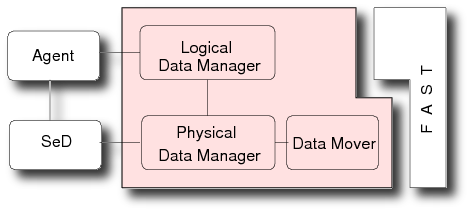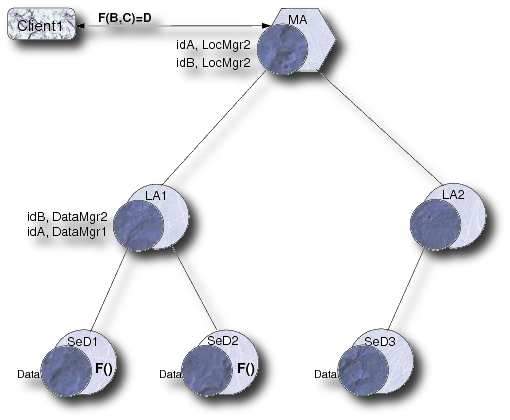DTM: Data Tree Manager (DTM)
A first data management service has been developed for the DIET platform called Data Tree Manager (DTM). This DIET data management model is based on two key elements: the data identifiers and the Data Tree Manager (DTM). To avoid multiple transmissions of the same data from a client to a server, the DTM allows to leave data inside the platform after computation while data identifiers will be used further by the client to reference its data.
Persistence mode
First, a client can choose whether a data will be persistent inside the platform or not. We call this property the persistence mode of a data. We have defined several modes of data persistence :
| Mode | Description |
|---|---|
| DIET_VOLATILE | not stored |
| DIET_PERSISTENT_RETURN | stored on server, movable and copy back to client |
| DIET_PERSISTENT | stored on server and movable |
| DIET_STICKY | stored and non movable |
| DIET_STICKY_RETURN | stored, non movable and copy back to client |
Table 1: Persistence Mode
In order to avoid interlacing between data messages and computation messages, the proposed architecture separates data management from computation management. The Data Tree Manager is build around three entities, the logical data manager, the physical data manager, and the data mover :
LocaManager object
The Logical Data Manager is composed of a set of LocManager objects. A LocManager is set onto the agent with which it communicates locally. It manages a list of couples (data identifier, owner) which represents data that are present in its branch. So, the hierarchy of LocManager objects provides the global knowledge of the localization of each data.
DataManager object
The Physical Data Manager is composed of a set of DataManager objects. The DataManager is located onto each SeD with which it communicates locally. It owns a list of persistent data. It stores data and has in charge to provide data to the server when needed. It provides features for data movement and it informs its LocManager parent of updating operations performed on its data (add, move, delete). Moreover, if a data is duplicated from a server to another one, the copy is set as non persistent and destroyed after it uses with no hierarchy update.
DTM and DIET
This structure is built in a hierarchical way. It is mapped on the DIET architecture. There are several advantages to define such a hierarchy. First, communications between agents (MA or LA) and data location objects (LocManager) are local like those between compu-tational servers (SeD) and data storage objects (DataManager). This ensures that a lower cost for the communication for agents to get information on data location and for servers to retrieve data. Secondly, considering the physical repartition of the architecture nodes (a LA front-end of a local area network for example), when data transfers between servers localized in the same subtree occur, the following updates are limited to this subtree. So, the rest of the platform is not involved in the updates.
The Data Mover provides mechanisms for data transfers between Data Managers objects as well as between computational servers. The Data Mover has also to initiate updates of DataManager and LocManager when a data transfer has finished.

